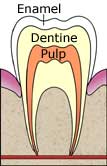


The two most commonly observed clinical effects of treatments with tooth whiteners include mild tooth over-sensitivity to temperature changes and irritation of the inside of the mouth in some patients. Increased tooth sensitivity, which often occurs at the beginning of the treatment and usually does not last more than a few days, was observed in up to two thirds of patients in various studies. Regarding irritation of the inside of the mouth, the mouthguard rather than the tooth whitening product may be the cause.
Some patients have also reported burning palate, throat, and gums and some of those who inadvertently swallowed whole tooth whitening strips reported minor upsets in their stomach or intestine.
In general, side effects can occur during treatment, but seem to disappear quickly afterwards.
The SCCP noted that the numbers of patients enrolled in the studies are too small to detect undesirable effects that occur very rarely. In addition, many studies do not include a control group to enable comparisons. No studies are available that would allow assessment of possible long-term effects connected with the use of tooth whitening products and of the effects of repeated use of such products. More...

Hydrogen peroxide applied on the tooth surface passes easily and quickly through tooth enamel. The majority of existing studies performed on enamel and dentin in the laboratory (in vitro) confirm that bleaching systems are safe.
However, a few studies focussing on effect on surface structure and chemistry have shown a degradation of the tooth surface associated with the whitening process. Indeed, some studies have reported alterations of enamel surfaces, including shallow depression, increased porosity and slight erosion, which is why some authors concluded that patients should be warned of the potential for enamel alteration and its detrimental effect on tooth structure even if long-term consequences are not yet conclusively determined. It should also be noted that soft drinks (e.g., Coca-Cola, Pepsi Cola) and fruit juices also cause demineralisation and alteration of enamel comparable to those reported for whitening products.
Some studies showed that saliva and fluoride have a remineralizing effect on the softened bleached surfaces of the teeth. The results of the numerous studies on the effects of peroxide-containing tooth whitening products on enamel and dentin depend on the methodology used and the materials tested.
Two clinical cases of serious adverse effects on enamel associated with the use of “over-the-counter” tooth whitening products were reported.
Studies measuring potential effects of toothwhiteners at the microscopic scale have shown no or very little effects on hardness and structure of dentin or enamel. More...
After crossing the enamel, hydrogen peroxide passes into dentin and pulp. The larger the dose of hydrogen peroxide, the greater the amount of peroxide that reaches the pulp. Products containing hydrogen peroxide lead to a greater penetration than those containing carbamide peroxide.
Despite this penetration, tooth whitening seems to do very little harm to the dental pulp of living teeth, possibly because the levels of hydrogen peroxide are too small to cause damage (by inhibiting enzymes in dental pulp).
However, studies show that whiteners can cause minor inflammation of the upper layers of pulp, where the pulp meets the dentin. It is noteworthy that such minor inflammation of the pulp occurs in parallel with increased tooth sensitivity, which is a well established common adverse effect of tooth whitening. More...
Tooth whitening does not usually change the colour of fillings and other restorative materials. Restorations made with composite materials (plastics) may lighten a little, but this is not noticeable to the human eye.
Tooth whitening has no effect on the chemistry or on the texture of porcelain, other ceramics, and dental gold.
However, tooth whitening products can slightly affect restorations made with composite materials, cements, and dental amalgams:

This summary is free and ad-free, as is all of our content. You can help us remain free and independant as well as to develop new ways to communicate science by becoming a Patron!